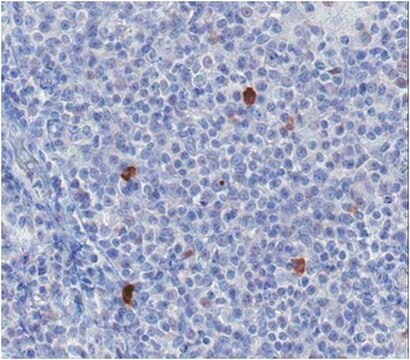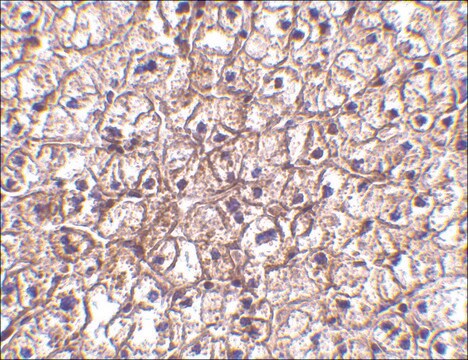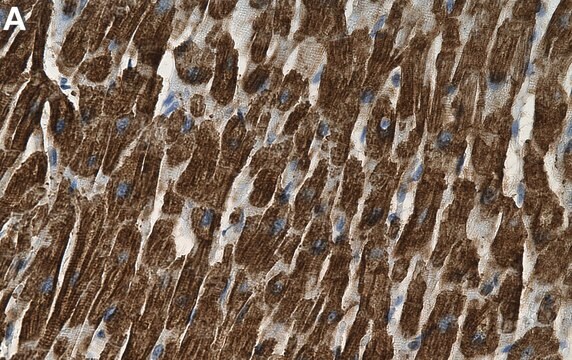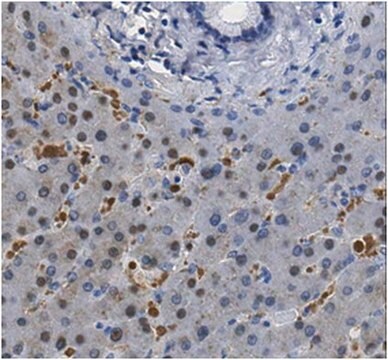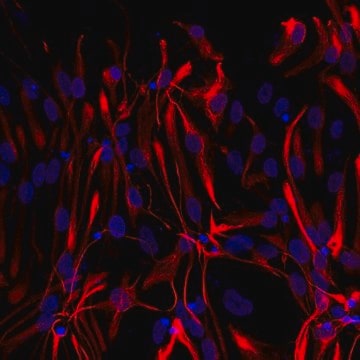MABF938
Anti-MxA, clone M143 (CL143)
clone CL143, from mouse
Synonym(s):
MxA, IFI-78K, Interferon-induced GTP-binding protein Mx1, Interferon-induced protein p78, Myxoma resistance protein 1, Myxovirus resistance 1, MX1
About This Item
Recommended Products
biological source
mouse
Quality Level
antibody form
purified immunoglobulin
antibody product type
primary antibodies
clone
CL143, monoclonal
species reactivity
guinea pig, human, mouse, rat
technique(s)
flow cytometry: suitable
immunohistochemistry: suitable (paraffin)
western blot: suitable
isotype
IgGκ
NCBI accession no.
UniProt accession no.
shipped in
wet ice
target post-translational modification
unmodified
Gene Information
human ... MX1 (4599)
Related Categories
General description
Specificity
Immunogen
Application
Immunohistochemistry Analysis: Representative lots detected MxA immunoreactivity in patients-derived skin lesion samples using paraffin-embedded tissue sections (Urosevic, M., et al. (2007). J. Clin. Invest. 117(10): 2834–2846; Urosevic, M., et al. (2005). J. Natl. Cancer Inst. 97(15):1143-1153).
Flow Cytometry Analysis: A representative lot detected MxA expression in MxA-transfected U-87-H4 and U-87-D11, but not untransfected U-87-K4 human gliobastoma cells (Schneider-Schaulies, S., et al. (1994). J. Virol. 68(11):6910-6917).
Western Blotting Analysis: A representative lot detected a robust MxA induction in the lung tissue from guinea pigs that recieved intranasal administration of recombinant human alpha-IFN (Van Hoeven, N., et al. (2009). J. Virol. 83(7): 2851–2861).
Western Blotting Analysis: A representative lot detected a time-dependent MxA induction in the lung tissue from rats following intraperitoneal Seoul virus inoculation (Hannah, M.F., et al. (2008). Brain Behav Immun. 22(4):503-516).
Immunoprecipitation Analysis: A representative lot immunoprecipitated MxA from murine MxA-expressing Swiss 3T3 cells (clone 4.5.15) (Flohr, F., et al. (1999). FEBS Lett. 463(1-2):24-28).
Inflammation & Immunology
Immunoglobulins & Immunology
Quality
Western Blotting Analysis: 0.5 µg/mL of this antibody detected MxA in 10 µg of Swiss 3T3 (clone 4.5.15) cell lysate.
Target description
Physical form
Storage and Stability
Other Notes
Disclaimer
Not finding the right product?
Try our Product Selector Tool.
Storage Class Code
12 - Non Combustible Liquids
WGK
WGK 1
Flash Point(F)
Not applicable
Flash Point(C)
Not applicable
Certificates of Analysis (COA)
Search for Certificates of Analysis (COA) by entering the products Lot/Batch Number. Lot and Batch Numbers can be found on a product’s label following the words ‘Lot’ or ‘Batch’.
Already Own This Product?
Find documentation for the products that you have recently purchased in the Document Library.
Our team of scientists has experience in all areas of research including Life Science, Material Science, Chemical Synthesis, Chromatography, Analytical and many others.
Contact Technical Service